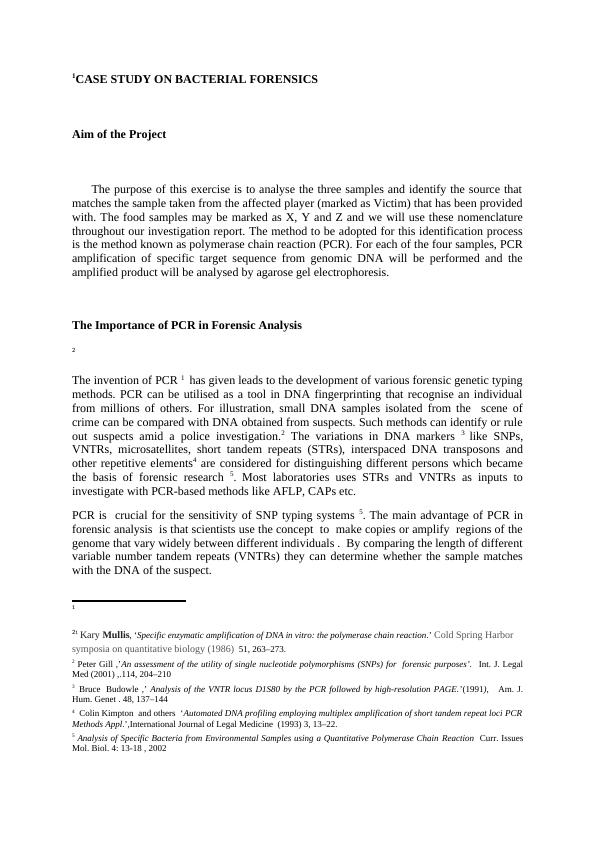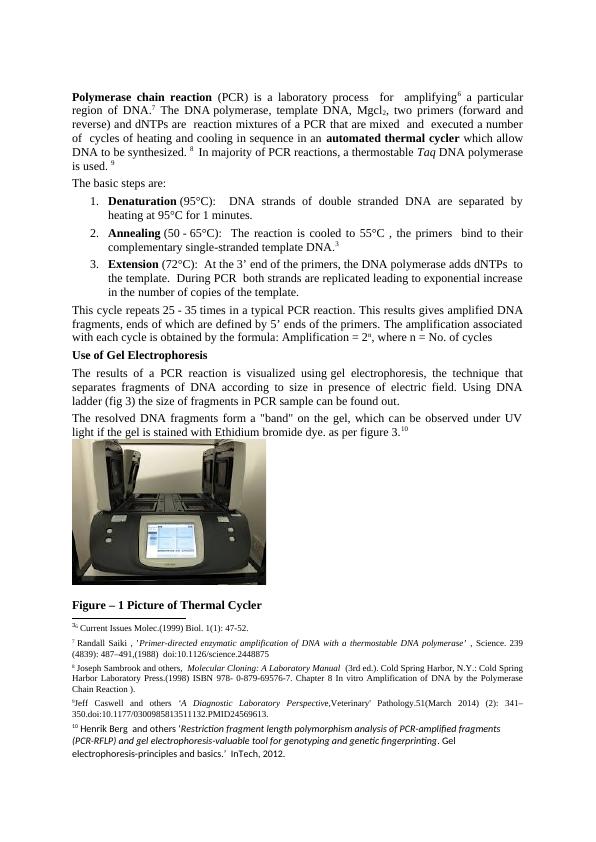Bacterial Forensics: PCR and Gel Electrophoresis Analysis
Added on 2023-05-28
7 Pages2229 Words394 Views
1CASE STUDY ON BACTERIAL FORENSICS
Aim of the Project
The purpose of this exercise is to analyse the three samples and identify the source that
matches the sample taken from the affected player (marked as Victim) that has been provided
with. The food samples may be marked as X, Y and Z and we will use these nomenclature
throughout our investigation report. The method to be adopted for this identification process
is the method known as polymerase chain reaction (PCR). For each of the four samples, PCR
amplification of specific target sequence from genomic DNA will be performed and the
amplified product will be analysed by agarose gel electrophoresis.
The Importance of PCR in Forensic Analysis
2
The invention of PCR 1 has given leads to the development of various forensic genetic typing
methods. PCR can be utilised as a tool in DNA fingerprinting that recognise an individual
from millions of others. For illustration, small DNA samples isolated from the scene of
crime can be compared with DNA obtained from suspects. Such methods can identify or rule
out suspects amid a police investigation.2 The variations in DNA markers 3 like SNPs,
VNTRs, microsatellites, short tandem repeats (STRs), interspaced DNA transposons and
other repetitive elements4 are considered for distinguishing different persons which became
the basis of forensic research 5. Most laboratories uses STRs and VNTRs as inputs to
investigate with PCR-based methods like AFLP, CAPs etc.
PCR is crucial for the sensitivity of SNP typing systems 5. The main advantage of PCR in
forensic analysis is that scientists use the concept to make copies or amplify regions of the
genome that vary widely between different individuals . By comparing the length of different
variable number tandem repeats (VNTRs) they can determine whether the sample matches
with the DNA of the suspect.
1
21 Kary Mullis, ‘Specific enzymatic amplification of DNA in vitro: the polymerase chain reaction.’ Cold Spring Harbor
symposia on quantitative biology (1986) 51, 263–273.
2 Peter Gill ,’An assessment of the utility of single nucleotide polymorphisms (SNPs) for forensic purposes’. Int. J. Legal
Med (2001) ,.114, 204–210
3 Bruce Budowle ,’ Analysis of the VNTR locus D1S80 by the PCR followed by high-resolution PAGE.’(1991), Am. J.
Hum. Genet . 48, 137–144
4 Colin Kimpton and others ‘Automated DNA profiling employing multiplex amplification of short tandem repeat loci PCR
Methods Appl.’,International Journal of Legal Medicine (1993) 3, 13–22.
5 Analysis of Specific Bacteria from Environmental Samples using a Quantitative Polymerase Chain Reaction Curr. Issues
Mol. Biol. 4: 13-18 , 2002
Aim of the Project
The purpose of this exercise is to analyse the three samples and identify the source that
matches the sample taken from the affected player (marked as Victim) that has been provided
with. The food samples may be marked as X, Y and Z and we will use these nomenclature
throughout our investigation report. The method to be adopted for this identification process
is the method known as polymerase chain reaction (PCR). For each of the four samples, PCR
amplification of specific target sequence from genomic DNA will be performed and the
amplified product will be analysed by agarose gel electrophoresis.
The Importance of PCR in Forensic Analysis
2
The invention of PCR 1 has given leads to the development of various forensic genetic typing
methods. PCR can be utilised as a tool in DNA fingerprinting that recognise an individual
from millions of others. For illustration, small DNA samples isolated from the scene of
crime can be compared with DNA obtained from suspects. Such methods can identify or rule
out suspects amid a police investigation.2 The variations in DNA markers 3 like SNPs,
VNTRs, microsatellites, short tandem repeats (STRs), interspaced DNA transposons and
other repetitive elements4 are considered for distinguishing different persons which became
the basis of forensic research 5. Most laboratories uses STRs and VNTRs as inputs to
investigate with PCR-based methods like AFLP, CAPs etc.
PCR is crucial for the sensitivity of SNP typing systems 5. The main advantage of PCR in
forensic analysis is that scientists use the concept to make copies or amplify regions of the
genome that vary widely between different individuals . By comparing the length of different
variable number tandem repeats (VNTRs) they can determine whether the sample matches
with the DNA of the suspect.
1
21 Kary Mullis, ‘Specific enzymatic amplification of DNA in vitro: the polymerase chain reaction.’ Cold Spring Harbor
symposia on quantitative biology (1986) 51, 263–273.
2 Peter Gill ,’An assessment of the utility of single nucleotide polymorphisms (SNPs) for forensic purposes’. Int. J. Legal
Med (2001) ,.114, 204–210
3 Bruce Budowle ,’ Analysis of the VNTR locus D1S80 by the PCR followed by high-resolution PAGE.’(1991), Am. J.
Hum. Genet . 48, 137–144
4 Colin Kimpton and others ‘Automated DNA profiling employing multiplex amplification of short tandem repeat loci PCR
Methods Appl.’,International Journal of Legal Medicine (1993) 3, 13–22.
5 Analysis of Specific Bacteria from Environmental Samples using a Quantitative Polymerase Chain Reaction Curr. Issues
Mol. Biol. 4: 13-18 , 2002

Polymerase chain reaction (PCR) is a laboratory process for amplifying6 a particular
region of DNA.7 The DNA polymerase, template DNA, Mgcl2, two primers (forward and
reverse) and dNTPs are reaction mixtures of a PCR that are mixed and executed a number
of cycles of heating and cooling in sequence in an automated thermal cycler which allow
DNA to be synthesized. 8 In majority of PCR reactions, a thermostable Taq DNA polymerase
is used. 9
The basic steps are:
1. Denaturation (95°C): DNA strands of double stranded DNA are separated by
heating at 95°C for 1 minutes.
2. Annealing (50 - 65°C): The reaction is cooled to 55°C , the primers bind to their
complementary single-stranded template DNA.3
3. Extension (72°C): At the 3’ end of the primers, the DNA polymerase adds dNTPs to
the template. During PCR both strands are replicated leading to exponential increase
in the number of copies of the template.
This cycle repeats 25 - 35 times in a typical PCR reaction. This results gives amplified DNA
fragments, ends of which are defined by 5’ ends of the primers. The amplification associated
with each cycle is obtained by the formula: Amplification = 2n, where n = No. of cycles
Use of Gel Electrophoresis
The results of a PCR reaction is visualized using gel electrophoresis, the technique that
separates fragments of DNA according to size in presence of electric field. Using DNA
ladder (fig 3) the size of fragments in PCR sample can be found out.
The resolved DNA fragments form a "band" on the gel, which can be observed under UV
light if the gel is stained with Ethidium bromide dye. as per figure 3.10
Figure – 1 Picture of Thermal Cycler
36 Current Issues Molec.(1999) Biol. 1(1): 47-52.
7 Randall Saiki , ’Primer-directed enzymatic amplification of DNA with a thermostable DNA polymerase’ , Science. 239
(4839): 487–491,(1988) doi:10.1126/science.2448875
8 Joseph Sambrook and others, Molecular Cloning: A Laboratory Manual (3rd ed.). Cold Spring Harbor, N.Y.: Cold Spring
Harbor Laboratory Press.(1998) ISBN 978- 0-879-69576-7. Chapter 8 In vitro Amplification of DNA by the Polymerase
Chain Reaction ).
9Jeff Caswell and others ‘A Diagnostic Laboratory Perspective,Veterinary' Pathology.51(March 2014) (2): 341–
350.doi:10.1177/0300985813511132.PMID24569613.
10 Henrik Berg and others ‘Restriction fragment length polymorphism analysis of PCR-amplified fragments
(PCR-RFLP) and gel electrophoresis-valuable tool for genotyping and genetic fingerprinting. Gel
electrophoresis-principles and basics.’ InTech, 2012.
region of DNA.7 The DNA polymerase, template DNA, Mgcl2, two primers (forward and
reverse) and dNTPs are reaction mixtures of a PCR that are mixed and executed a number
of cycles of heating and cooling in sequence in an automated thermal cycler which allow
DNA to be synthesized. 8 In majority of PCR reactions, a thermostable Taq DNA polymerase
is used. 9
The basic steps are:
1. Denaturation (95°C): DNA strands of double stranded DNA are separated by
heating at 95°C for 1 minutes.
2. Annealing (50 - 65°C): The reaction is cooled to 55°C , the primers bind to their
complementary single-stranded template DNA.3
3. Extension (72°C): At the 3’ end of the primers, the DNA polymerase adds dNTPs to
the template. During PCR both strands are replicated leading to exponential increase
in the number of copies of the template.
This cycle repeats 25 - 35 times in a typical PCR reaction. This results gives amplified DNA
fragments, ends of which are defined by 5’ ends of the primers. The amplification associated
with each cycle is obtained by the formula: Amplification = 2n, where n = No. of cycles
Use of Gel Electrophoresis
The results of a PCR reaction is visualized using gel electrophoresis, the technique that
separates fragments of DNA according to size in presence of electric field. Using DNA
ladder (fig 3) the size of fragments in PCR sample can be found out.
The resolved DNA fragments form a "band" on the gel, which can be observed under UV
light if the gel is stained with Ethidium bromide dye. as per figure 3.10
Figure – 1 Picture of Thermal Cycler
36 Current Issues Molec.(1999) Biol. 1(1): 47-52.
7 Randall Saiki , ’Primer-directed enzymatic amplification of DNA with a thermostable DNA polymerase’ , Science. 239
(4839): 487–491,(1988) doi:10.1126/science.2448875
8 Joseph Sambrook and others, Molecular Cloning: A Laboratory Manual (3rd ed.). Cold Spring Harbor, N.Y.: Cold Spring
Harbor Laboratory Press.(1998) ISBN 978- 0-879-69576-7. Chapter 8 In vitro Amplification of DNA by the Polymerase
Chain Reaction ).
9Jeff Caswell and others ‘A Diagnostic Laboratory Perspective,Veterinary' Pathology.51(March 2014) (2): 341–
350.doi:10.1177/0300985813511132.PMID24569613.
10 Henrik Berg and others ‘Restriction fragment length polymorphism analysis of PCR-amplified fragments
(PCR-RFLP) and gel electrophoresis-valuable tool for genotyping and genetic fingerprinting. Gel
electrophoresis-principles and basics.’ InTech, 2012.

In this case, the PCR reaction was performed based on the protocol as provided in Figure 2.
Figure 2. Schematic representation of the PCR reaction plan. [There are 5 major stages:
initial denaturation, denaturation, annealing, extension and final extension. Each stages is
carried out at a distinct temperature and for a specific period of time. Stage 2, 3, 4 was
repeated 34 times, denoting the PCR to be carried out for 34 cycles.]
Figure 2. Schematic representation of the PCR reaction plan. [There are 5 major stages:
initial denaturation, denaturation, annealing, extension and final extension. Each stages is
carried out at a distinct temperature and for a specific period of time. Stage 2, 3, 4 was
repeated 34 times, denoting the PCR to be carried out for 34 cycles.]

End of preview
Want to access all the pages? Upload your documents or become a member.
Related Documents
Medical Biotechnology Assignmentlg...
|8
|2030
|14
Experiment Discussion Description: Taq DNA Polymerase Chain Reactionlg...
|6
|1217
|229
Polymerase Chain Reaction (PCR) and Its Medical Applicationslg...
|7
|2003
|126
Polymerase Chain Reactionlg...
|8
|1594
|51
DNA and the law assessmentlg...
|11
|2765
|19
DNA Profiling in Parental Testing: Methods, Social Issues, and Historylg...
|2
|2466
|471